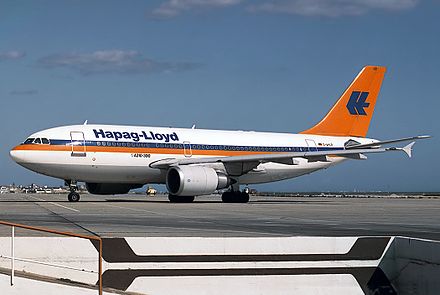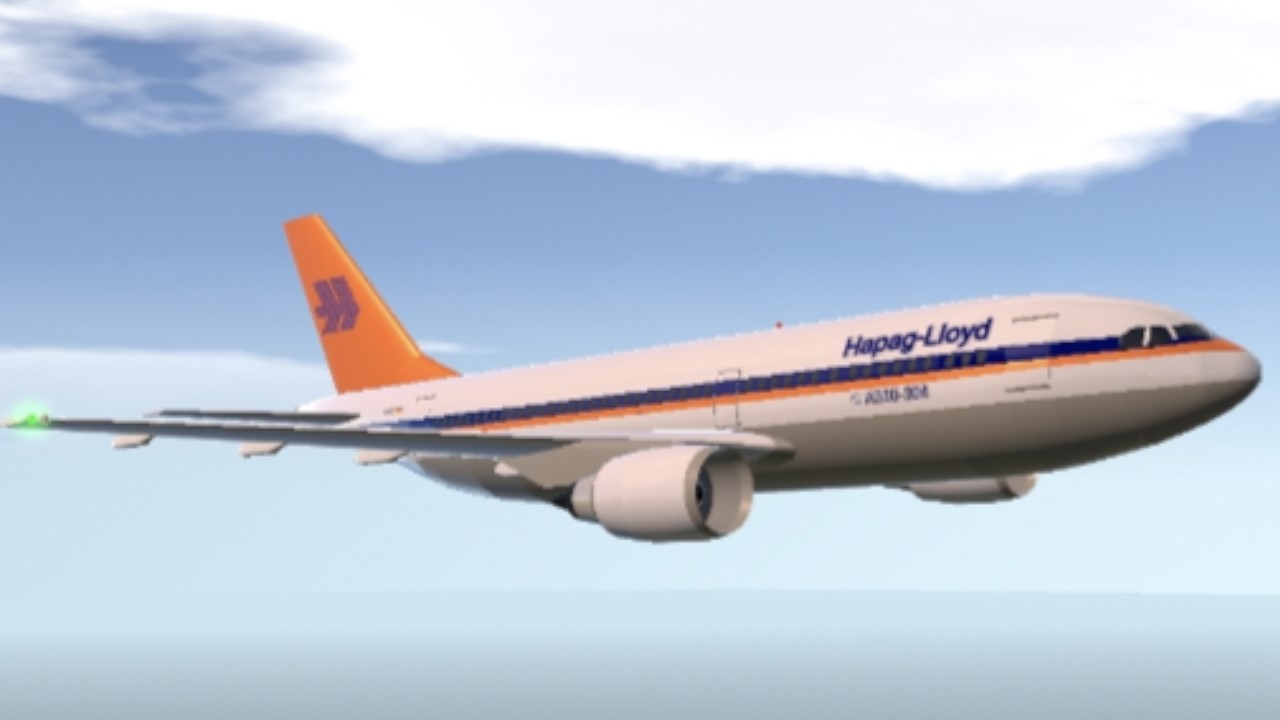Controls:
Ag1 - Arm Speed brakes (requires gear down)
Ag2-4 - Strobe/Landing/Cabin Lights
Ag5 - Open front left door (Requires not moving)
AG6 - Pushback
AG8 - Engines, Nav/Taxi/Beacon lights
About Hapag-Lloyd:
Hapag-Lloyd Flug GmbH (marketed as Hapagfly between 2005 and 2007) was a German leisure airline headquartered in Langenhagen, Lower Saxony that was originally founded by Hapag-Lloyd and later became a subsidiary of TUI Group. It operated scheduled and charter passenger flights mainly to holiday resorts in Europe. Its successor is today's TUI fly Deutschland.

Hapag-Lloyd Flug was established in July 1972, two years after HAPAG merged with Norddeutscher Lloyd, when the Hapag-Lloyd shipping group bought a few Boeing 727s to fly its cruise passengers from Germany to the ports of call for the cruises. It began operations on 30 March 1973. With the boom of the holiday charter flight market in the 1970s, it quickly adopted charter flights to popular holiday destinations in the Mediterranean Sea area and the Canary Islands as well and soon became one of the biggest German charter airlines. Throughout the years, the airline added regular passenger flights to its schedule, as well as new airplanes, such as the Boeing 737-100 and Airbus A310 aircraft. In 1979, Bavaria Germanair, a charter air carrier operating Airbus A300B4 and British Aircraft Corporation BAC One-Eleven series 400 and 500 jets, was merged into Hapag-Lloyd Flug.
In 1998, it became the first airline in the world to adopt the Boeing 737-800.
Mergers and rebranding:
Since 1997, it had been a subsidiary of TUI AG, which also includes the Hapag-Lloyd cargo container line and cruise line. When TUI released their new "big smile" logo in 2002, the Hapag-Lloyd livery that had remained unchanged for almost 30 years was completely changed to a new, light blue, white and red scheme with the new TUI logo on the tail to represent TUI's new corporate design. 2002 also saw the founding of Hapag-Lloyd Express, a low-cost airline that was to compete with the likes of Ryanair.
In November 2005, the airline changed its name to Hapagfly due to the new marketing strategy of the TUI Group. In January 2007 in a restructuring, it combined its operations with Hapag-Lloyd Express to become TUIfly, for which it operated all flights, while Hapag-Lloyd Express marketed them until TUIfly got its own license.
Incident:

D-AHLB, the aircraft involved in the accident, in 1992
Captain Arminger (56), was the pilot-in-command. The flight departed at 10:59 CEDT, shortly after which it was found to be impossible to fully retract the landing gear, as indicated by both the red "gear unsafe" lamp and the yellow "gear door open" lamp. After a total of four retraction attempts, the gear was left in the fully extended condition where all lights indicated a valid condition with the doors trimmed for cruise airspeed. The flight continued towards Germany, as fuel must be burned before landing in any case. The crew had to cope with a heavier cockpit workload that was aggravated by the unavailability of the airline HF radio station for technical consultation, forcing the first officer to spend almost an hour establishing alternative communications with the airline through ACARS and Stockholm Radio. Using the Flight Management System (FMS), the crew estimated the aircraft's fuel consumption, and the captain in consultation with dispatch decided to shorten the flight and divert to Munich Airport, where another A310 would be ready to take the passengers to their final destination. However, the captain ignored the fact that the FMS was not designed to take into account the extra drag produced by the extended landing gear. In fact, Munich was not within range, as eventually became clear from the unexpectedly rapid fall in fuel reserves. At about 12:00 CEDT, this led the captain to decide to divert to Vienna-Schwechat Airport.
Shortly thereafter, the first officer noted and reported to the captain that they had already consumed half of their initial fuel load, although they had progressed to only their last waypoint "YNN" still inside Greece (about a third of the total distance to Vienna). At 12:34, the FMS prediction for fuel remaining upon arrival at Vienna fell to 1.9 t. Under such conditions, the airline rules require immediate diversion to the nearest suitable airport, which would have been Zagreb, 10 minutes away. The investigation report states "there was no evidence of immediate crew response to this situation." While contact with Zagreb ATC was made 9 minutes later, the crew pressed on towards Vienna, requesting the most direct access to a runway. At 12:53, the crew notified Vienna ATC that if direct runway access were not available, they would prefer to divert to closer Graz. This prompted Vienna ATC to inquire and finally learn that the flight was short of fuel, but the pilots declared no emergency, still anticipating a normal landing. When the fuel gauges fell through 1.9 t remaining, the first officer twice urged the captain to declare an emergency, but the captain postponed such action. At 13:01, the "LT-Fuel low level" warning indicated remaining fuel of 1340 kg, which automatically generates an ACARS message. At this time, the aircraft was 42 nautical miles (78 km) northeast of Zagreb, 85 nautical miles (157 km) south-east from Graz, and 131 nautical miles (243 km) from the destination Vienna. At 11:07 UTC, the crew finally declared an emergency due to lack of fuel, while still stating that they expected to reach Vienna.
At this point, the crew was still debating a possible diversion to Graz, but discovered that the approach chart for that airport was missing from the aircraft map collection. At 11:12 UTC, the crew still debated the contribution of the FMS to their flight; the first officer (correctly) distrusted its performance with gear down, while the captain still defended it. The captain instructed the first officer to request no emergency services for post-landing, and to defer deployment of the flaps, especially if the engines flamed out. At 11:26 UTC, the pressure dropped at the inlet of the right external fuel pump, but the pump was left running. Both engines flamed out 12 nautical miles (22 km) from the runway, although the first officer was able to restart them for a few more minutes of thrust. As there was no time for the final checklist, the "Land Recovery" switch was neglected, resulting in limited operation of inboard ailerons needed for stability control at low speeds. The left wing tip hit the grassy surface about 660 m short of the runway, followed by the left landing gear, which collapsed after 22 m. The aircraft skidded on the left engine and the right main landing gear, over arrays of approach lights and antennas, turning left 90°, and coming to rest off the runway near the end taxiway. About 26 passengers received minor injuries while using the escape slides. Although the photographs suggest that the aircraft remained structurally intact, it was written off due to the severe damage to the underside of the fuselage. This was the sixth hull-loss of an Airbus A310.
Investigation
The final Report on the investigation of the incident was published (only in German) on 21 March 2006 by the Air Accident Investigation Board (Flugunfalluntersuchungsstelle) of the Austrian Federal Office for Transport (Bundesanstalt für Verkehr, BAV). The Report identified the cause of the failure of landing gear retraction as a minor oversight during maintenance; an inadequately secured lock nut allowed a screw to gradually turn, eventually leading to a 10 mm adjustment error that prevented complete retraction.
The Report identified several key reasons why the cockpit crew failed to adequately cope with this relatively minor technical malfunction of the landing gear, continuing the flight to engine failure due to fuel exhaustion.
•The crew failed to comply with company regulations regarding
fuel reserves, caused by several human factors, most importantly
extreme work load and stress, leading to loss of situational
awareness.
•Fuel reserves were determined exclusively using the FMS, due to
lack of awareness of its inapplicability with gear down.
•The captain failed to divert to nearby Zagreb airport upon
receiving the low-fuel level warning, apparently becoming
excessively single-goal oriented.
•Airbus documentation failed to adequately and clearly inform
flight crew of the limitations that apply to fuel management using
the FMS.
The airline provided insufficient documentation in the checklist for "abnormal landing gear up indication," and Operations Division provided inadequate review of fuel requirements.
The Report makes 14 recommendations for improvements in systems, documents and procedures to avoid such problems in future.
Criminal prosecution:
Hapag-Lloyd reported that the Captain Arminger voluntarily left the airline six months after the incident. In 2004, a Hannover district court convicted Captain Arminger of "dangerous interference in the air traffic," saying he was "endangering others' lives" mainly by failing to divert to Zagreb, and gave him a six-month suspended prison sentence. The conviction was criticized by German court reporter Gisela Friedrichsen who thought the two court sessions of the main trial were not enough to present and evaluate all evidence.
A report published in 2012 by the American Bar Association argues that airline safety is undermined by such prosecutions because its threat would impede the investigative processes.
Specifications
General Characteristics
- Predecessor A310-300[GE]
- Successors 8 airplane(s) +329 bonus
- Created On Android
- Wingspan 144.0ft (43.9m)
- Length 153.1ft (46.7m)
- Height 55.5ft (16.9m)
- Empty Weight N/A
- Loaded Weight 104,924lbs (47,592kg)
Performance
- Power/Weight Ratio 1.091
- Horse Power/Weight Ratio 0.028
- Wing Loading 31.7lbs/ft2 (154.7kg/m2)
- Wing Area 3,311.1ft2 (307.6m2)
- Drag Points 12239
Parts
- Number of Parts 488
- Control Surfaces 9
- Performance Cost 3,119







Note: this isnt a gold special, im just doing requests.
Tags:
@CoachPickles86
@AverageFedExMD11 Thanks
@Pilothasya137 someone u follow prob spotlight this or someone u follow posted this.
Ayo why there IS a hapag Lloyd a310 in my jetstream
@LM0418 thanks!
I haven’t seen any HAPAG-Lloyd planes on this website (as I know of.) Good job!